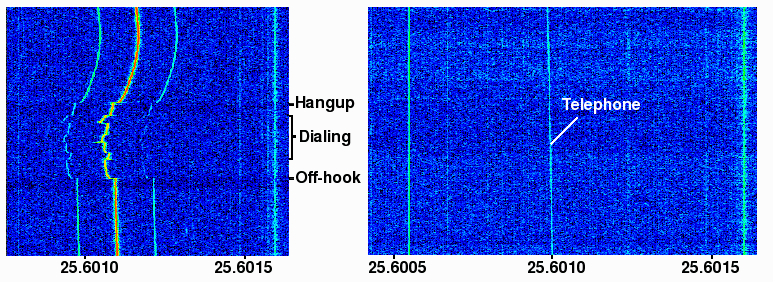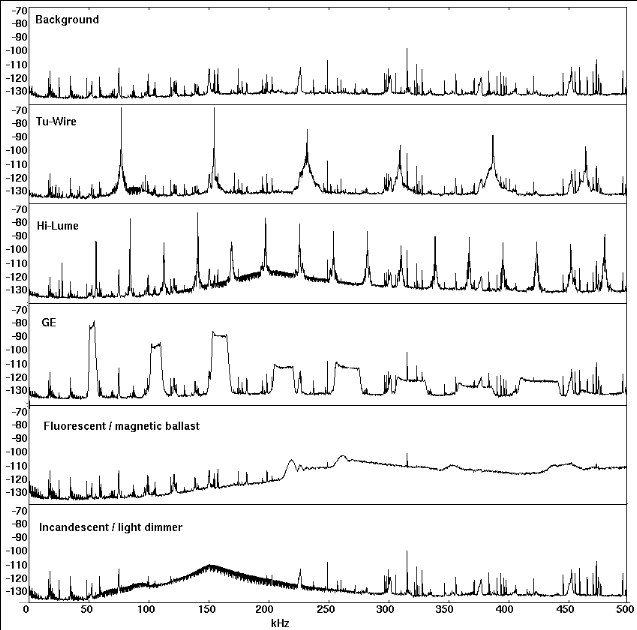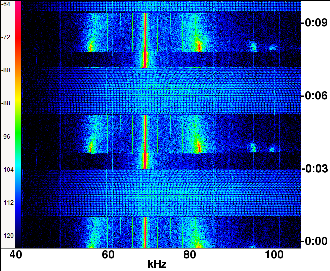Identifying Sources of Radio Frequency Interference Around the Home
Most people associate radio frequency interference (RFI) with electricity that is arcing through the air, as when a power connector is corroded or has become loose. But in recent years, many consumer devices have become widely available that contain circuits that are intrinsically noisy. These devices contain Class D amplifiers and power supplies that use silicon controlled rectifiers (SCRs). Digital circuits in computers and computer networking equipment are also intrinsically noisy, because of the rapid acceleration and deceleration of electrons at high processing speeds.
This page describes the results of some tests with a portable spectrum analyzer in my attempts to identify the sources of RFI around the house. Radio interference was found in a number of unexpected places. Each type of interference has a characteristic signature that can aid in finding the source. In some cases, the RFI can be easily eliminated. In others, the only sure way to eliminate the interference is with the repeated application of small-arms fire.
Eliminating RF interference is not just something you do for fun. Static on the radio could be a sign of faulty electrical wiring. Fixing it could save your life.
Computer networks
The biggest source of interference was from the computer network which, in this case, consists of a small number of PCs connected through a network switch with Cat 5e cable. The computer network produced a comb of carriers spaced about 30.5 kHz apart that made reception difficult above 17 MHz (see figure below). This RFI was a problem only when a computer was plugged into a network hub or switch. Clamping large ferrites over the network cables and the switch's power cable had little effect. Changing to a D-Link DGS-1016D network switch, which is in a metal box instead of the plastic case used by the previous hub and switch, reduced the RFI from S7 to S3 (where background noise was S2) on some frequencies. However, other frequencies still had RFI at S6-S7. The RFI was reduced from S7 to nearly undetectable levels when the Cat 5e cable was replaced with shielded Cat 5e cable.
On a radio, this interference just sounds like an unmodulated carrier. There is no buzzing sound, but often a faint whine or hum.

The above figure shows the interference from the network switch
in the VHF region. In this example, the antenna was positioned in close
proximity to the switch. The amplitude of these spikes is actually fairly
small, and a switch or hub by itself produces only a small amount of interference.
However, unless shielded patch cables and wiring are used, the network
cables act as an antenna and can broadcast this interference over a wide area,
easily reaching 25-50 feet from the source.
This part of the spectrum is used by aircraft communicating with their control tower. If a passenger plugged a network cable into their laptop, it would radiate a comb of carriers like this, which could easily wipe out the plane's reception of ground control signals. No wonder the FAA bans computers on airplanes.
A TV show called Mythbusters once tested whether radio interference from a computer could cause a plane to crash. As usual, they tested the wrong thing and got the wrong result!
VCRs and DVD Players
Interference on upper HF was also produced by a Sony SLV-N900 VCR, and was present even when the VCR was turned off. It turned out that this VCR is supplied with no ferrites on the power cord. I cut the power cord (after unplugging it) and wrapped it several times through a large toroidal ferrite. This reduced the interference from the VCR from S8 to undetectable levels.
No spectra are available for the DVD player, as it is in the shop having a number of small holes repaired (and to have some small pieces of lead that somehow got inside it removed).
Uninterruptible Power Supplies
Some UPSs produce a very interesting and distinctive pattern of interference that is time- and frequency-dependent. For example, an APC Back-Ups RS-1500 uninterruptible power supply (the newer model with the LCD display on the front) produced radio interference in longwave and in the upper part of the HF band. When heard on a radio, the RFI consists of periodic bursts of buzzing sounds about once every three seconds. The burst is repeated every 69 kHz; however, in the lower frequencies the bursts remained at a constant frequency, while in the HF region, they swept upwards in frequency. The interference is not conducted through the power cable, but was emitted from the front and sides of the unit. It was strong enough to be detectable 15-20 feet away. The only solution was to get rid of the UPS. An older model Back-UPS XS-1500 did not produce radio frequency interference.
This upward sweeping is somewhat similar to the "mooing" cow-like sounds that are often heard in the longwave region. (These sounds are obviously not real cows; it is well known that cows only use Morse code on this band.)
APC Back-Ups RS-1500 in longwave region (click to enlarge)

APC Back-Ups RS-1500 in HF region (click to enlarge)
I finally got rid of the RS-1500 and replaced it with a Smart-UPS 1000. We have several of these in the lab and they are very reliable and relatively interference-free.
Telephones
You might expect a cell phone or portable wireless phone to be a potential
source of interference. But many non-wireless telephones also contain oscillators
that emit an unstable sine wave around 25.6 MHz. These telephones aren't a major
source of interference, since this signal is only on a single frequency, but they
are easily detectable up to 50 feet away. Somewhat disturbingly, on one phone,
a Nortel 9516CW, I found that dialing a number produced a series of frequency
deflections. The size of the deflection was different for each digit, allowing
the number you are calling to be easily identified from a distance.
If other phones exhibit this behavior, it could pose a widespread privacy risk.

The image at left shows the deflections when three digits were dialed,
and the image at right shows the phone signal measured from an outside
antenna about fifty feet away. Note that the phone's frequency continues
to drift during the measurements. On a radio, it sounds like an unmodulated
carrier that drifts by a couple hundred Hz the first twenty minutes after
the phone is plugged in.
Fluorescent Lamps
Fluorescent lamps produce a characteristic series of spikes in the longwave and lower MW bands. This noise has a pronounced 60 Hz hum or buzz.
Different types of electronic ballasts have markedly different RF spectra. In this test, I measured the noise with a low-gain antenna one foot away from the ballast. Because my neighbors have lamps that eradicate all reception below 600 kHz between the hours of 5 PM and 1AM, all the measurements shown here were taken before 4 PM local time.
Lutron dimming fluorescent ballasts emit their energy in a sharp band with harmonics extending above 500 kHz into the AM radio band. The Tu-Wire was the worst, with peaks up to -70 dB in my setup. When the lamp is dimmed, a small amount of broadband noise is also evident between the major peaks. Non-dimming ballasts, such as the ballast in the GE F21T5 fixture shown here, tend to have broader bands, with markedly reduced intensity above the third harmonic. The sixth harmonic (around 320 kHz) is already down to -120 decibels. This indicates that the ballast in this lamp has a relatively low THD.
Fluorescents with magnetic ballasts also produce small amounts of
radio frequency interference over a very broad spectrum, but the
levels are very low compared to electronic ballasts (the y axis
in the figure is in decibels, which is a logarithmic scale).
Light dimmers also produce broadband interference. The light
dimmer in this case was farther away, about ten feet from the
antenna.

Remediation: Some lamps can be rewired to reduce RFI (See here. )
Incandescent lamps
Incandescent lamps do not produce radio frequency interference. However, some halogen lamp fixtures have an internal transformer that reduces the voltage to 12 volts or so. These transformers often produce RFI similar to that produced by light dimmers.
Treadmills
Just recently, I found a new source of radio frequency interference: a
Precor exercise treadmill. The motor generates very strong interference
that blankets the radio spectrum from 0 to 30 MHz (see figure below). The
antenna in the first two graphs below is a monopole about 30 feet from the
house.

Even though the closest point of the antenna in these measurements was outdoors
and over 30 feet from the treadmill, noise was increased by up to 20 dB above
background across a broad region from the AM band through the HF. It's impossible
to pick up any AM broadcast stations within 15 feet of this treadmill when it is
running. It's possible that the treadmill would interfere with DSL traffic as well.

The treadmill even radiates in the VHF region. This interference is not
coming from the control panel or the heart monitor, but from the drive motor.
This is apparent when listening to the noise with a radio: a low-pitched hum
can be heard that changes when the treadmill is stepped on.
The figure above shows the spectrum in the VHF just above the airband used by
commercial aviation. The narrow spikes in this figure are from the local
computer networking equipment, and are about the same size as a typical aircraft
signal. I don't want to single out Precor; most likely, other treadmills have
the same problem. But one can't help asking, where was the FCC when these
machines were being tested?

Measuring closer to the source (4 feet away), it's evident that most reception
up to 30 MHz is blocked. Because the antenna in this case is indoors, numerous
spikes from the computer network are also visible between 10 and 23 MHz.

A higher resolution FFT shows that the interference consists of a large number
of evenly-spaced, high amplitude spikes, indicating that it is the power supply,
not the motor itself, that is producing the interference. It has always been a
difficult challenge for engineers to design an efficient and lightweight
variable-speed power supply. Unfortunately, manufacturers have chosen to use
pulse-width modulation (or "chopped DC power"), similar to what is done with
AC in cheap light dimmers. However, because of the higher power, the interference
produced by treadmills is much worse than even the worst light dimmer.
If someone invites you to ride on an airplane that has a treadmill in it, my advice is to politely decline.
How to Detect Bad Wiring in Your House
Bad electrical wiring produces RF interference in the longwave band (that is, the low frequency region between 30 and 300 kHz). It usually has the highest intensity around 160-260 kHz. On a radio, this noise is superimposed on a loud 60- and 120-Hz buzzing. Constant buzzing sounds detected by a radio held next to an electrical wire are usually normal, but if the buzzing varies over time, or if it contains little clicks, static, muffled crackling sounds, or other noises, it could mean big trouble. Any such RF noises should be tracked down and eliminated immediately. (If you can hear a buzzing and crackling noise without a radio, that is obviously even worse.)
Abnormally loud buzzing on the radio can also be a sign of bad wiring, particularly if it's coming from underground. In the past, contractors sometimes used buried “underground feeder” (UF) plastic cable instead of conduit to carry electrical lines to a house or outbuilding. This is no longer permissible in many locations, because the insulation can get damaged by sharp rocks, and because people making repairs to other utilities can easily cut through the cable and get killed. However, many electricians still use UF cable. Unscrupulous ones might use ordinary outdoor nonmetallic (NM) cable. This is illegal and extremely dangerous.
The easiest way to track down a wiring fault is to tune a portable shortwave radio to just above the peak of the buzzing sound, and listen at various places on the wall. I use a Sony ICF-SW100 radio, which has an internal ferrite antenna, and can be tuned down to 150 kHz. The Eton NGWTIIIB Traveler Radio is another good choice. You can also buy suitable radios cheaply from England (for example at Radioworld or Amazon.co.uk ), because low frequencies are still used in Europe and the UK for broadcasting. In an emergency, an ordinary AM radio could also be used, if it can be tuned to a frequency where buzzing is heard when it's placed next to the wall within a few inches of the wire. Obviously, something has to be using current for this method to work--ideally, it should be something like an incandescent bulb that doesn't make noise itself.
On one occasion, I heard faint clicking noises superimposed on the buzzing on one side of my house. The noises disappeared when one particular circuit breaker was turned off. Although the noises were faint (and hard to describe), I decided to find out what was causing them. In order to do that, I had to cut fifteen large holes in the drywall ceiling of my basement (the previous owner had “finished” the basement), and I traced the noisy circuit until I eventually found a junction box hidden in the ceiling. One of the wires branching from this box went through the outside wall to another box under the deck. When this wire was disconnected, the noise stopped. It turned out that the original contractor had used ordinary indoor NM wire, drilled a hole in the wall, run the wire through the hole, and connected it to an ordinary steel box under the deck. The plastic insulation and the paper lining of this wire were completely rotted away. The wire was so badly corroded that it was impossible to pull it out; I had to use an electric drill to clear the hole.
It turned out that the hole was full of black material from oxidized copper and charred wood. The electricity had been shorting out inside the wall whenever it rained and water seeped in through the hole (which had not been sealed). Those faint clicking sounds on the radio were the only warning I would have received before this wire burned my house to the ground. (I found out later that this had actually happened to the previous house built by this builder.) Every place in the house where a wire went to the outside had to be ripped out and re-done.
I would like to add that this same idiot contractor had also run indoor NM all over the underside of my deck--without installing a single GFCI as required by code. The wire then ran underground (with no conduit-- also illegal!), halfway across my front lawn, to a set of floodlights on the ground next to a tree. There was also a receptacle, with no conduit, nailed to a railroad tie, in the middle of the yard, three inches above the ground (also with no GFCI). The receptacle was no longer live because the buried indoor NM wire had rotted away some time ago, but it had obviously been live at some time in the past, as evidenced by black burn marks all around the plug. It goes without saying that all of this was an egregious violation of the electrical code, and I ripped it out immediately. (Oh, you might ask, why didn't my inspector find all this when I was buying the place? I have a theory about that, too.) But the moral is: never ignore an unidentified noise source. If in doubt, call an electrician. Or ask a ham radio operator for help--those guys are the real experts at finding these things!
Update, Nov 6 2019: Arc fault circuit interrupters are available that do the same thing automatically. When they detect low-frequency signals on the wiring they trip the circuit. They tend to be finicky and expensive, but could be well worth the investment.
Back

